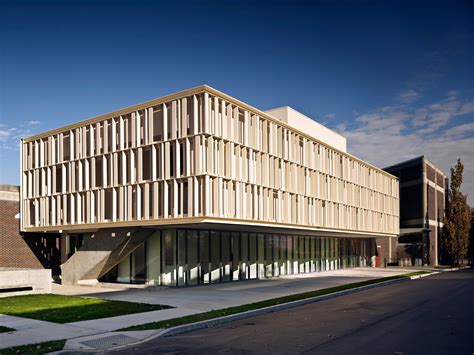As the global focus on environmental sustainability continues to increase, the demand for professionals with expertise in sustainable architecture is growing rapidly. This has led to a shift in architectural education, with more emphasis being placed on integrating sustainable principles and practices into curricula at universities across the United States. From innovative technologies to collaborative projects and field experiences, the opportunities for students to learn and engage in sustainable architecture are expanding.
In this blog post, we will explore the various aspects of sustainable architecture programs at US universities. From the integration of sustainable design principles to the promotion of eco-friendly materials and green building certifications, these programs are at the forefront of preparing the next generation of architects to address the environmental challenges of tomorrow. We will also delve into the research initiatives and sustainable urban planning curricula that are shaping the future of architectural education in the United States. Join us as we examine the exciting developments in sustainable architecture programs and the impact they are having on the industry.
Table of Contents
Growing demand for sustainable architecture professionals
In today’s world, there is a growing demand for sustainable architecture professionals who are equipped with the skills and knowledge to address the pressing environmental challenges we face. With increasing awareness about climate change and the need for more eco-friendly solutions, architects who specialize in sustainable design are becoming increasingly sought after in the industry.
As the world shifts towards a more sustainable and eco-friendly mindset, the role of architecture professionals has also evolved. Clients are now looking for designs that not only meet their functional and aesthetic needs but also minimize their impact on the environment. This has created a growing need for architects who are well-versed in sustainable design principles and can integrate them into their projects.
With the rise of green building certifications and a focus on eco-friendly materials, the demand for architects who understand and can implement these practices has never been higher. Whether it’s designing energy-efficient buildings, incorporating renewable materials, or using innovative sustainable technology, the need for professionals who can bring these elements into their work is on the rise.
Given this growing demand, it’s clear that the future of architecture lies in sustainability. As a result, architecture schools are integrating sustainability into their curricula, and students are engaging in collaborative projects and gaining field experiences that focus on sustainable design. This shift in education is preparing the next generation of architects to meet the demands of a rapidly changing industry.
Integrating sustainability into architecture curricula
As the world becomes more aware of the impact of human activity on the environment, there is a growing demand for sustainable architecture professionals who can design and build eco-friendly structures. To meet this demand, architecture curricula are evolving to include a stronger focus on sustainability.
Architecture students are now learning about innovative sustainable technology that can be integrated into their designs. This includes the use of eco-friendly materials and the implementation of sustainable design principles to minimize the environmental impact of their projects.
Collaborative projects are also becoming more common in architecture education, allowing students to work together to develop sustainable urban planning solutions. These projects give students valuable experience in field experiences and encourage them to think critically about how their designs can contribute to a more sustainable future.
Furthermore, many architecture programs are now offering green building certifications to students who demonstrate a strong understanding of sustainable design and construction practices. This not only prepares students for a career in sustainable architecture but also promotes the integration of sustainability into the broader architecture industry.
Innovative sustainable technology in architectural education
As the demand for sustainable architecture professionals continues to grow, it is essential for architectural education to adapt and integrate innovative sustainable technology into its curricula. Students pursuing a career in architecture need to be equipped with the knowledge and skills necessary to design and build sustainable structures that minimize environmental impact.
By incorporating sustainable technology into architectural education, students can gain hands-on experience with the latest advancements in eco-friendly building materials, energy-efficient systems, and green building certifications. This exposure to innovative sustainable technology not only prepares students for the evolving demands of the industry but also encourages them to think critically and creatively about sustainable design solutions.
Moreover, the integration of sustainable technology in architectural education fosters a culture of environmental awareness and responsibility among future architects. Through collaborative projects and field experiences, students can explore the impact of sustainable design principles on urban planning and research initiatives, gaining a holistic understanding of the interconnectedness between architecture and sustainability.
Overall, the incorporation of innovative sustainable technology in architectural education is crucial in preparing the next generation of architects to address the challenges of sustainable urban development and promote eco-friendly practices in the built environment.
Collaborative projects for sustainable architecture students
In today’s rapidly changing world, the demand for sustainable architecture professionals is increasing at a staggering rate. As such, it is crucial for architecture curricula to prioritize integrating sustainability into their programs. One innovative approach to achieving this is through collaborative projects for sustainable architecture students.
These projects allow students to work together to tackle real-world challenges in sustainable design, promoting a deeper understanding of the complexities involved in creating environmentally conscious structures. By working in teams, students can pool their resources, creativity, and knowledge, resulting in more effective and innovative solutions.
Moreover, collaborative projects foster a sense of community among students, encouraging them to share ideas and learn from each other’s unique perspectives. This not only enriches their educational experience but also prepares them for the collaborative nature of the architecture profession.
By engaging in collaborative projects, sustainable architecture students are equipped with the practical experience and teamwork skills necessary to lead the way in creating a more environmentally sustainable future.
Field experiences in sustainable architecture education
Field experiences play a crucial role in providing students with hands-on learning opportunities in sustainable architecture education. These experiences allow students to apply theoretical knowledge to real-world scenarios, gaining practical insights into the challenges and opportunities of sustainable design and construction.
By participating in field experiences, students are able to engage in collaborative projects that address real environmental and social issues. This not only enhances their understanding of sustainable architecture principles, but also fosters a sense of responsibility and ethical decision-making in their future professional practice.
Through these experiences, students have the opportunity to work closely with industry professionals, gaining valuable mentorship and networking opportunities. This not only enriches their learning experience, but also provides them with a better understanding of the sustainable architecture industry and the practical applications of their education.
Ultimately, field experiences in sustainable architecture education help bridge the gap between theory and practice, preparing students to become knowledgeable, skilled, and socially responsible professionals in the field of sustainable architecture.
Sustainable design principles taught in architecture programs
In today’s world, the demand for sustainable design principles is increasing at a rapid pace. As the environmental concerns become more pressing, it is essential for architecture programs to emphasize the integration of sustainable design principles into their curricula. The future of our planet depends on architects and designers who are well-versed in sustainable design practices.
Architectural education plays a crucial role in promoting eco-friendly and sustainable design principles. Students who are pursuing a career in architecture need to have a thorough understanding of how their designs can impact the environment and society. Therefore, it is imperative for architecture programs to incorporate sustainable design principles into their coursework.
By teaching sustainable design principles, architecture programs can prepare the next generation of architects to tackle environmental challenges and create buildings that are energy-efficient, environmentally friendly, and sustainable. Students should be encouraged to explore innovative technologies and materials that can minimize the ecological footprint of their designs.
Furthermore, architecture programs should also focus on the collaborative aspects of sustainable design. Students should engage in projects that require them to work in teams and develop sustainable solutions for real-world problems. This hands-on approach can provide students with invaluable experience and prepare them for the challenges they may face in their future careers.
Promoting eco-friendly materials in architectural education
As the world becomes increasingly aware of the environmental impact of human activities, the architectural industry is also moving towards sustainability. One way to promote eco-friendly practices in architecture is by incorporating the use of eco-friendly materials in architectural education.
By teaching students about the benefits and applications of sustainable materials such as bamboo, recycled steel, and reclaimed wood, architecture programs can prepare the next generation of designers to create environmentally responsible buildings and structures.
Furthermore, promoting the use of eco-friendly materials in architectural education can inspire students to seek out innovative and environmentally conscious solutions in their future design projects, thus driving the industry towards a more sustainable future.
Overall, the promotion of eco-friendly materials in architectural education plays a crucial role in shaping the mindset and practices of future architects and is a vital step towards achieving a more sustainable built environment.
Sustainable urban planning in architecture curricula
As the world continues to urbanize, the need for sustainable urban planning becomes increasingly important. In response to this, many architecture curricula are now integrating sustainable urban planning into their programs. This shift is vital in ensuring that future architects are equipped with the knowledge and skills to design cities that are not only aesthetically pleasing, but also environmentally friendly, socially inclusive, and economically viable.
By incorporating sustainable urban planning into their curricula, architecture schools are preparing students to address the challenges of rapid urbanization, resource scarcity, and climate change. This includes teaching them how to create green spaces, design walkable neighborhoods, implement public transportation systems, and minimize urban sprawl. Students are also learning about the importance of mixed-use development, energy-efficient buildings, and resilient infrastructure in urban planning.
Furthermore, the inclusion of sustainable urban planning in architecture curricula allows students to explore interdisciplinary approaches to city design, where they can collaborate with urban designers, environmental scientists, sociologists, and policymakers. This exposure to diverse perspectives not only enriches their learning experience, but also prepares them to work in multidisciplinary teams once they enter the workforce.
Overall, the integration of sustainable urban planning into architecture curricula is a positive step towards building a future generation of architects who are well-versed in creating cities that are environmentally sustainable, socially equitable, and economically prosperous.
Green building certifications in sustainable architecture programs
As the awareness of environmental sustainability continues to grow, the demand for green building certifications in sustainable architecture programs has seen a significant rise. These certifications are essential for architects and designers who are committed to creating buildings that are environmentally responsible and resource-efficient.
Obtaining a green building certification demonstrates a commitment to sustainable design practices and provides professionals with the knowledge and skills needed to create buildings that minimize their environmental impact. In architecture programs, students are encouraged to pursue these certifications as part of their education, equipping them with the necessary tools to become leaders in the field of sustainable architecture.
Some of the most recognized green building certifications include LEED (Leadership in Energy and Environmental Design), WELL Building Standard, and Living Building Challenge. These certifications focus on various aspects of sustainability, such as energy efficiency, indoor air quality, water conservation, and material selection.
By integrating green building certifications into sustainable architecture programs, educational institutions are preparing the next generation of architects to address the challenges of climate change and environmental degradation through innovative and sustainable design practices.
Sustainable research initiatives at US architecture universities
When it comes to sustainability and architecture, research plays a crucial role in driving innovation and progress. In the United States, many architecture universities are spearheading sustainable research initiatives to address the growing need for environmentally conscious design and construction practices.
These initiatives focus on a wide range of topics, from energy-efficient building materials to green urban planning strategies. Through interdisciplinary collaboration and cutting-edge technology, architecture students and faculty are working together to develop sustainable solutions for the built environment.
Research efforts at US architecture universities also extend beyond the campus, with partnerships and community engagement playing a vital role in addressing real-world sustainability challenges. By working closely with industry partners and local organizations, students and researchers are able to tackle complex issues and implement sustainable practices on a larger scale.
Ultimately, sustainable research initiatives at US architecture universities are shaping the future of the industry, equipping the next generation of architects and designers with the knowledge and skills to create a more sustainable built environment.






